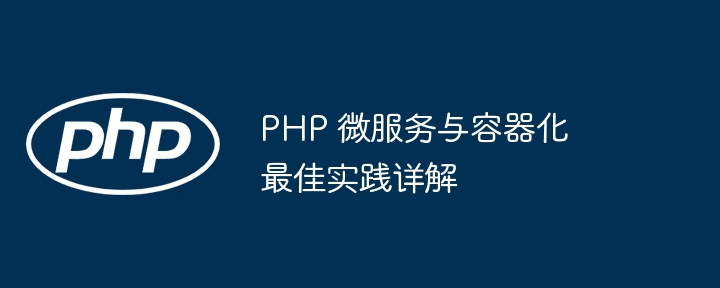Home >Backend Development >PHP Tutorial >Detailed explanation of best practices for PHP microservices and containerization
Detailed explanation of best practices for PHP microservices and containerization
- WBOYWBOYWBOYWBOYWBOYWBOYWBOYWBOYWBOYWBOYWBOYWBOYWBOriginal
- 2024-05-08 21:27:02748browse
PHP best practices for microservices include decomposing applications, defining clear APIs, using message buses, and implementing the circuit breaker pattern. Containerization best practices include using orchestration tools, creating custom images, automating builds and deployments, persisting data volumes, and implementing load balancing and automatic scaling. A hands-on example of a microservices eCommerce website demonstrates these practices in action, where microservices are packaged as Docker images and orchestrated and managed using Kubernetes.

Detailed Explanation of PHP Microservices and Containerization Best Practices
Microservice architecture is known for its flexibility, scalability and agility popular among developers. Containerization is an ideal deployment method for microservices because it provides isolation, portability, and resource management.
PHP Microservices Best Practices
- Decompose a single application: Decompose a large monolithic application into independent, loose Coupled microservices.
- Clearly defined API: Each microservice should have a clearly defined API to facilitate communication with other services and clients.
- Use a message bus: Use a message bus (such as RabbitMQ or Kafka) for asynchronous communication between microservices.
- Implement service discovery: Ensure microservices can easily locate each other, such as using Eureka or Consul.
- Implement circuit breaker mode: Prevent microservice failures from cascading to the entire system.
PHP Containerization Best Practices
- Use container orchestration tools: such as Docker Swarm, Kubernetes or OpenFaaS, for Orchestration and management of microservice containers.
- Create custom images: Build custom container images for each microservice, including only the required dependencies.
- Leverage automated builds and deployments: Set up a CI/CD pipeline to automate the build and deployment of microservice images.
- Persistent data volume: Mount the persistent data volume to store microservice status and persistent data.
- Implement load balancing and auto-scaling: Use load balancers and auto-scaling mechanisms to ensure the availability and performance of microservices.
Practical Case: Microservices eCommerce Website
Consider a microservices eCommerce website with the following components:
- Product Service: Manage product catalog.
- Shopping Cart Service: Process the items in the user’s shopping cart.
- Order Service: Process orders and communicate with inventory service.
- Inventory service: Manage product inventory.
- Payment Services: Process payments and communicate with external payment gateways.
Containerized deployment:
Each microservice is packaged as its own Docker image and orchestrated and managed using Kubernetes.
- Kubernetes automatically scales microservices, adding or removing containers based on demand.
- The Ingress controller handles communication with the outside world, routing traffic to the appropriate microservice.
- Persistent data volumes are used to store user shopping carts, orders, and other persistent data.
The above is the detailed content of Detailed explanation of best practices for PHP microservices and containerization. For more information, please follow other related articles on the PHP Chinese website!

